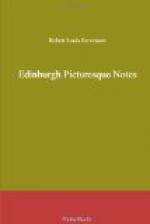Setting aside the tombs of Roubiliac, which belong to the heroic order of graveyard art, we Scotch stand, to my fancy, highest among nations in the matter of grimly illustrating death. We seem to love for their own sake the emblems of time and the great change; and even around country churches you will find a wonderful exhibition of skulls, and crossbones, and noseless angels, and trumpets pealing for the Judgment Day. Every mason was a pedestrian Holbein: he had a deep consciousness of death, and loved to put its terrors pithily before the churchyard loiterer; he was brimful of rough hints upon mortality, and any dead farmer was seized upon to be a text. The classical examples of this art are in Greyfriars. In their time, these were doubtless costly monuments, and reckoned of a very elegant proportion by contemporaries; and now, when the elegance is not so apparent, the significance remains. You may perhaps look with a smile on the profusion of Latin mottoes — some crawling endwise up the shaft of a pillar, some issuing on a scroll from angels’ trumpets — on the emblematic horrors, the figures rising headless from the grave, and all the traditional ingenuities in which it pleased our fathers to set forth their sorrow for the dead and their sense of earthly mutability. But it is not a hearty sort of mirth. Each ornament may have been executed by the merriest apprentice, whistling as he plied the mallet; but the original meaning of each, and the combined effect of so many of them in this quiet enclosure, is serious to the point of melancholy.
Round a great part of the circuit, houses of a low class present their backs to the churchyard. Only a few inches separate the living from the dead. Here, a window is partly blocked up by the pediment of a tomb; there, where the street falls far below the level of the graves, a chimney has been trained up the back of a monument, and a red pot looks vulgarly over from behind. A damp smell of the graveyard finds its way into houses where workmen sit at meat. Domestic life on a small scale goes forward visibly at the windows. The very solitude and stillness of the enclosure, which lies apart from the town’s traffic, serves to accentuate the contrast. As you walk upon the graves, you see children scattering crumbs to feed the sparrows; you hear people singing or washing dishes, or the sound of tears and castigation; the linen on a clothes-pole flaps against funereal sculpture; or perhaps the cat slips over the lintel and descends on a memorial urn. And as there is nothing else astir, these incongruous sights and noises take hold on the attention and exaggerate the sadness of the place.




